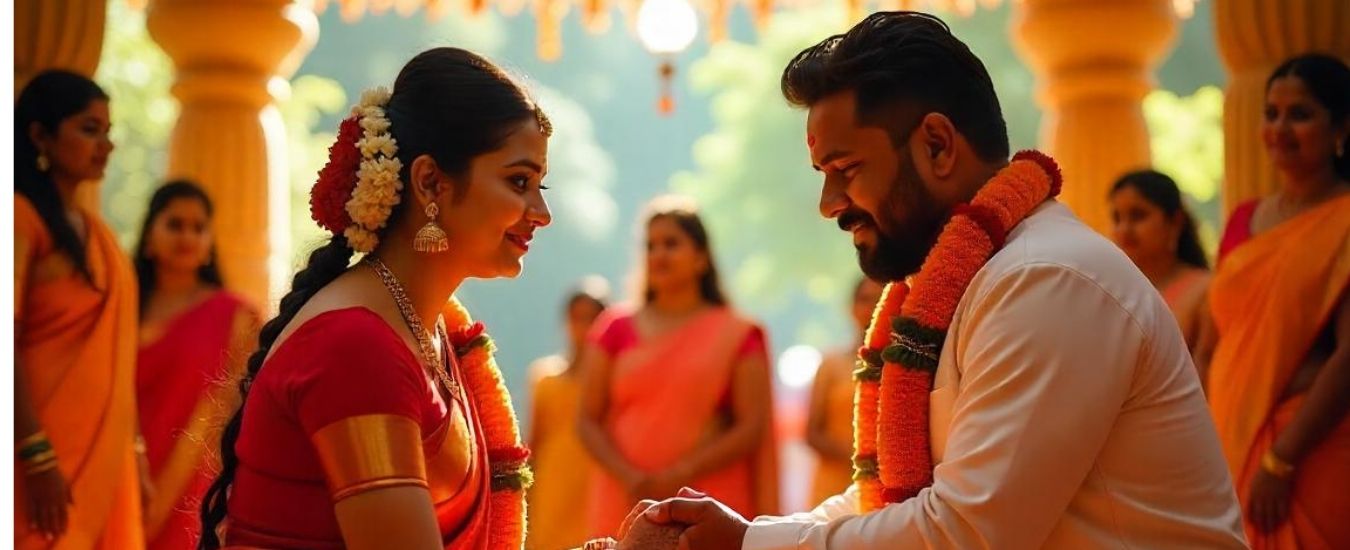A Telugu Hindu wedding is a celestial story told through rituals, music, symbols, and family unity. It’s not just a celebration—it’s an invocation of divine love stitched with heritage and grace.
Let’s face it—Hindu weddings are a whirlwind of colour, customs, and centuries-old culture. But when you zoom into the Telugu matrimonial tradition, you discover a vibrant universe of symbolism, family bonding, and Vedic-era rituals passed down through generations.
Telugu weddings—celebrated by Telugu-speaking communities of Andhra Pradesh and Telangana—are much more than a marriage ceremony. They are spiritual unions where sacred mantras, ancestral blessings, and symbolic acts come together to create a celebration of love, dharma, and divine grace.
Pre-Wedding Rituals and Sacred Customs
Nischitartham – The Engagement Ceremony
This is the formal agreement of marriage by both families, often marked by the exchange of gifts and a muhurtham card announcement.
Horoscope Matching and Subhamuhurtam
The journey begins with matching kundalis under Purohit’s guidance. Once cosmic alignment is confirmed, an auspicious Subhamuhurtam (date and time) is chosen.
Pendlikoothuru – Bridal Glow Ritual
In this cheerful rite, both the bride and groom are smeared with turmeric paste and herbal oil, believed to purify the soul and bring bridal radiance.
Snathakam – Groom’s Sacred Thread Ceremony
Held at the groom’s ancestral home, he dons a silver sacred thread, symbolizing the shift from bachelorhood to marital responsibility.
Kashi Yatra – Playful Renunciation
The groom theatrically vows to renounce worldly life and head to Kashi, only to be lovingly stopped by the bride’s brother, symbolizing commitment to the marriage path.
Telugu Wedding Day Rituals with Spiritual Significance
Mangala Snanam – Holy Bath
Performed at dawn, this ritual bath spiritually prepares the couple. It’s followed by adorning turmeric-dyed attire and floral garlands.
Gauri Puja – Seeking the Goddess’s Blessing
The bride worships Goddess Gauri, praying for strength, marital harmony, and fertility.
Kanyadaanam – A Sacred Giving
A moment of spiritual gravity: the bride’s parents offer her hand to the groom, invoking the Agni Sakshi (fire as a witness) and chanting Vedic mantras.
Jeelakarra Bellam – The Divine Paste
A defining moment. The couple places a paste of jeera (cumin) and bellam (jaggery) on each other’s heads, symbolizing the bittersweet unity of life.
Mangalsutra Dharana – Tying the Sacred Thread
The groom ties the mangalsutra—adorned with two gold pendants and black beads—around the bride’s neck, securing it with three sacred knots (mudi), each representing a vow to uphold dharma, artha, and kama.
Saptapadi – Seven Steps Around the Fire
Together, they walk seven steps around the fire. Each step invokes a marital vow, from family health to lifelong companionship.
Post-Wedding Rituals and Eternal Bonds
Arundhati Nakshatram – Cosmic Blessings
The couple is shown the Arundhati and Vasistha stars, symbols of fidelity and eternal partnership.
Grihapravesham – Entering the Groom’s Home
The bride kicks over a pot of rice, ushering abundance and setting foot into a new phase of life.
Satyanarayana Vratam – Prayer for Harmony
A joint puja to Lord Vishnu, this ritual marks their first religious observance as a couple.
Telugu Wedding Attire: Tradition Meets Elegance
For the Bride
She drapes a richly woven Kanjeevaram or Pattu saree, often dyed with natural pigments and adorned with traditional motifs. Her gold jewellery often includes a Vaddanam (waist belt), Maang Tikka, and Temple-style necklaces.
For the Groom
Dressed in a crisp dhoti, angavastram, and often a turban (kanduva), the groom reflects serenity and spiritual resolve.
Food, Music & Festivities
Traditional Telugu Wedding Feast
Served on banana leaves, the spread includes Pulihora, Gongura pachadi, Pappu, Poornalu, and an array of sweets. It’s a culinary homage to regional flavour and abundance.
Folk Music and Harikatha
Carnatic performances, Nadhaswaram, and Harikatha storytelling set a rhythmic, devotional backdrop.
Regional & Modern Influences
From Coastal Andhra to Rayalaseema
Each region adds its flair—decor in Coastal Andhra, Oggu Katha performances in Telangana, and simplified rituals in Rayalaseema.
Modern Twists
Today’s Telugu couples embrace destination weddings, eco-conscious decor, and pre-wedding photography, blending heritage with flair.
FAQs
What is the meaning of Jeelakarra Bellam?
Jeelakarra Bellam symbolizes the blending of two souls through the union of opposites—cumin (spice) and jaggery (sweet). It represents harmony in marriage.
How long does a traditional Telugu wedding last?
It usually spans 3 to 5 days, with pre-wedding rituals, the wedding day, and post-wedding ceremonies.
Is the Mangalsutra the same in all South Indian weddings?
Not exactly. While all Mangalsutras have symbolic value, designs and customs differ across regions. The Telugu version often includes two pendants tied together by the groom in three knots.
What should guests wear to a Telugu wedding?
Go ethnic and vibrant! Women can wear sarees or lehengas, while men can opt for kurtas or dhotis. Avoid black or white—brighter is better.
Can non-Telugu people follow the wedding rituals?
Absolutely! With the help of the priest and family, anyone can participate or follow along. Telugu families are often welcoming and love to explain their traditions.
